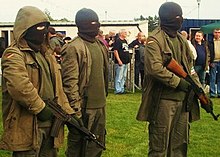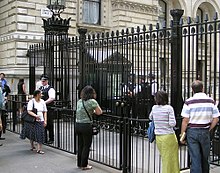History of the Irish Republican Army
The Irish Republican Army (IRA, German Irish Republican Army ) is a name in the history of the Irish freedom movement that was used many times in new editions and splits from organizations, for example in the 20th and 21st centuries by various paramilitary organizations in Ireland . In addition, the name (and the acronym IRA ) was used in the 1860s by the Fenian Brotherhood , the counterpart in the USA to the Irish Republican Brotherhood , namely for the paramilitary associations of the American Fenians.
All organizations which is in English call the IRA carry official in the Irish language , the name Óglaigh na hÉireann ( "Volunteers of Ireland") without any addition in succession of the Irish Volunteers . The same name is used by the armed forces of the Republic of Ireland, the Irish Defense Forces .
Organizations in Ireland

The late 20th century IRA is known as the Provisional Irish Republican Army . The political movement as a whole is devoted to irredentism through Irish republicanism , the belief that all of Ireland should be an independent republic and free from British rule. The original Irish Republican Army was formed in 1917 from those Irish volunteers who did not enroll in the British Army during World War I , members of the Irish Citizen Army, and others. Their ranks were strengthened by the Irish, who were in the First World War in the British Army and returned to Ireland in the Irish War of Independence against Great Britain to fight. Under Irish law, this IRA was the Army of the Republic of Ireland as declared by the Dáil Éireann in 1919 . Some Irish, however, deny the claims of the later founded organizations to be the only legitimate successor to the original IRA, often called the "Old IRA".
The playwright Brendan Behan , a former IRA member, once said that the first item on the agenda of an Irish organization was "the split ". For the IRA, this has often been the case. The first split came after the Anglo-Irish Treaty of 1921, with the proponents of the treaty forming the core of the National Army of the newly created Irish Free State , while the opponents continued to use the name "Irish Republican Army". After the end of the Irish Civil War (1922-23), the IRA existed in one form or another for forty years, until in 1969 it was split into the Official IRA and the Provisional IRA . The latter then had its own spin-offs, namely the Real IRA and the Continuity IRA , each claiming to be the true successor to the Irish Republican Army.
The main organizations:
- The Irish Republican Army (1919–1922) (later known as the "Old IRA"), which was recognized by the First Dáil in April 1921 as the legitimate army of the Irish Republic and fought in the Irish War of Independence . After the Anglo-Irish Treaty was ratified by the Dáil, it split into treaty-friendly forces (the national army, also known as "government forces" or "regulars") and anti-treaty forces (the "republicans", "irregulars" or "executive forces") . These two groups continued to fight in the Irish Civil War .
- The Irish Republican Army (1922-1969) , the anti-treaty forces of the Old IRA, which fought and lost the civil war and then refused to recognize either the Irish Free State or Northern Ireland , considering both to be creations of British imperialism . It existed in one form or another for 40 years before it was split up in 1969.
- The Official IRA (OIRA), the remainder of the IRA after the 1969 spin-off of the Provisionals; in the political struggle it primarily pursued Marxism . It is now inactive in a military sense, while the Official Sinn Féin political wing has become the Workers' Party of Ireland .
- The Provisional IRA (PIRA) broke away from the OIRA in 1969 because of abstentionism and dealing with the increasing violence in Northern Ireland. The PIRA killed more people than any other organization in Northern Ireland until 2005, when it declared the end of its armed struggle. Although it was against the Marxism of the OIRA, it developed a leftist orientation and increased political activity.
- The Continuity IRA (CIRA) split off from the PIRA in 1986 because the latter ended its policy of abstentionism (thereby recognizing the authority of the Republic of Ireland ).
- The Real IRA (RIRA), a 1997 spin-off from the PIRA, consisting of members who opposed the Good Friday Agreement .
- In April 2011, former Provisional IRA members announced the resumption of hostilities, claiming they were doing so on behalf of the Irish Republican Army, independently of the Real IRA, Óglaigh na hÉireann (ONH) and Continuity IRA. They assumed responsibility for the murder of a constable of the Northern Irish Police, as well as other attacks for which the Real IRA and ONH had previously claimed responsibility.
- The New IRA , which was founded in 2012 as a merger of the Real IRA and other Republican groups, see Real IRA .
Genealogy of the IRA and its spin-offs
|
Irish Volunteers (1913-1914) |
|||||||||||||||||||||||||||||||||||||||||
|
National Volunteers (1914) |
Irish Volunteers (1914-1917) |
||||||||||||||||||||||||||||||||||||||||
|
Irish Republican Army (1919-1922) |
|||||||||||||||||||||||||||||||||||||||||
| (Per contract ) IRA (1922) |
(Contra contract ) IRA | ||||||||||||||||||||||||||||||||||||||||
|
National Army (1922-1924) |
GHQ | Executive | |||||||||||||||||||||||||||||||||||||||
|
Irish Defense Forces (since 1924) |
IRA | ||||||||||||||||||||||||||||||||||||||||
|
Saor Uladh (1955) |
|||||||||||||||||||||||||||||||||||||||||
|
Official IRA (1969–1972) |
Provisional IRA (1969–1998) |
||||||||||||||||||||||||||||||||||||||||
|
Irish National Liberation Army (1974-2009) |
Direct Action Against Drugs (1994-2005) |
Continuity IRA (since 1986) |
|||||||||||||||||||||||||||||||||||||||
|
Irish People's Liberation Organization (1986–1996) |
Real IRA (1997-2012) |
Republican Action Against Drugs (2008-2012) |
Irish Republican Liberation Army (since 2006) |
||||||||||||||||||||||||||||||||||||||
|
New IRA (since 2012) |
Óglaigh na hÉireann (2006–2009) |
||||||||||||||||||||||||||||||||||||||||
|
Óglaigh na hÉireann (2009-2018) |
Saoirse na hÉireann (2006–2009) |
||||||||||||||||||||||||||||||||||||||||
| Remnants of the Real IRA (since 2012) |
Irish Republican Movement (since 2018) |
Arm na Poblachta (since 2017) |
|||||||||||||||||||||||||||||||||||||||
literature
- Tim Pat Coogan: Michael Collins. a biography . Hutchinson, London 1990, ISBN 0-09-174106-8 .
- Tim Pat Coogan: DeValera. Long Fellow, Long Shadow . Hutchinson, London 1993, ISBN 0-09-175030-X .
- John Joseph Lee: Ireland 1912–1985. Politics and Society . Cambridge University Press, Cambridge 1989, ISBN 0-521-26648-3 .
See also
Individual evidence
- ^ TP Coogan: The IRA. Fully revisited and updated . New York 2002, p. 15 (English).
- ^ The Origins Of The Name Irish Republican Army Or IRA. To Sionnach Fionn, September 27, 2014 (English).
- ^ TP Coogan: 1916: The Easter Rising . 2005, p. 138 .
- ^ Sheila Lawlor: Great Britain and Ireland 1914-23 . Ed .: Gill and Macmillan. 1983, p. 38 .
- ↑ Primates' creative ambiguity averts schism. The Irish Times, February 2, 2005 .
- ↑ Official IRA. Northern Ireland: The Troubles. BBC (English).
- ↑ Provisional IRA. Northern Ireland: The Troubles. BBC (English).
- ↑ Suzanne Breen: Former Provos claim Kerr murder and vow more attacks. Belfast Telegraph, April 22, 2011 (English).
- ^ Cormac O'Keeffe: New IRA 'will be unaffected' by murder on Derry street. Irish Examiner, April 27, 2019 (English).


